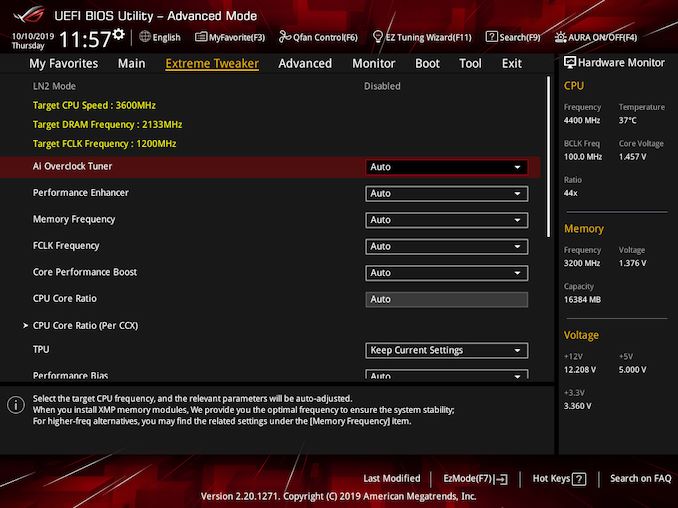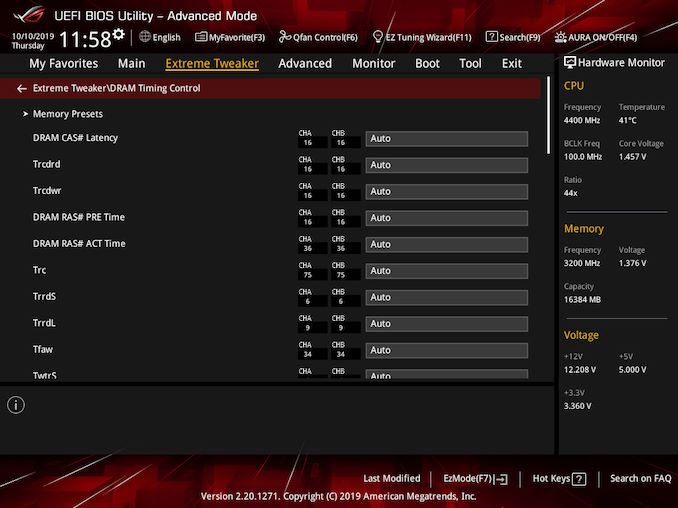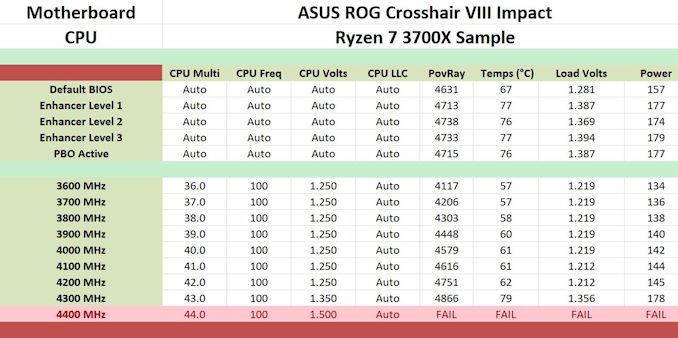The ASUS ROG Crosshair VIII Impact: A Sharp $430 Impulse on X570
by Gavin Bonshor on October 25, 2019 11:30 AM ESTOverclocking Ryzen 3000
Experience with the ASUS ROG Crosshair VIII Impact
Overclocking with the ASUS ROG firmware on the ROG Crosshair VIII Impact is quite pleasant as all of the overclocking related options are located in the Extreme Tweaker menu. For most users looking to overclock the Ryzen 3000 processors, the primary settings to change are the CPU Core Frequency, CPU VCore voltage; memory overclocking can be done automatically by enabling the X.M.P memory profile which ASUS calls D.O.C.P. To make fine-tuned adjustments, ASUS includes plenty of voltage and SoC options, although the ROG Crosshair VIII Impact doesn't support the integrated graphics of the Ryzen APUs as there are no video outputs on the rear panel.
There are no CPU overclocking presets to select from, but users can enable one of the memory presets which are a good starting point for high-binned memory; not only is this expensive but due to the locked Infinity Fabric clock-speed, it becomes less effective without making FCLK adjustments beyond using DDR4-3600 memory. Users can use the firmware fine-tune the primary, secondary, and tertiary memory latencies in the DRAM Timing Control section.
Users looking to make performance-enhancing changes will need to rely on manually overclocking the processors. This is something ASUS ROG is very competent at providing with a whole host of customizable frequency, voltage, and power-related settings for users to chomp on. The firmware on the ASUS ROG Crosshair VIII Impact is well equipped for overclocking, it's very responsive to use and works well. For the more extreme overclockers, there is plenty to appreciate with lots of scope for LN2 cooling with its overclocker's toolkit, an LN2 specific mode, and lots of extreme memory profiles to use as a starting point.
Overclocking Methodology
Our standard overclocking methodology is as follows. We select the automatic overclock options and test for stability with POV-Ray and OCCT to simulate high-end workloads. These stability tests aim to catch any immediate causes for memory or CPU errors.
For manual overclocks, based on the information gathered from the previous testing, starts off at a nominal voltage and CPU multiplier, and the multiplier is increased until the stability tests are failed. The CPU voltage is increased gradually until the stability tests are passed, and the process repeated until the motherboard reduces the multiplier automatically (due to safety protocol) or the CPU temperature reaches a stupidly high level (105ºC+). Our testbed is not in a case, which should push overclocks higher with fresher (cooler) air.
Overclocking Results
The ASUS ROG Crosshair VIII Impact is very efficient with its VDroop at all of the tested frequencies with the firmware set to the auto LLC setting. From 3.6 GHz to 4.2 GHz with 1.250 V set on the CPU VCore in the firmware, we experienced around 0.038 V of VDroop compensation. This not only reduces the overall power consumption at maximum load, but it also helps to reduce CPU temperatures. Moving up to 4.3 GHz at 1.350 V on the CPU VCore, we saw a slight increase to this value at load with a CPU VCore of 1.356 V. We know our Ryzen 7 3700X processor is capable of running 4.3 GHz with slightly less load VCore, but it seems the firmware was playing it safe with a focus on overclocking stability. Our POV-Ray benchmark performance was consistent as we went up in each 100 MHz frequency stepping. The limit on our Ryzen 7 3700X with our testbed cooler is 4.3 GHz, and the Impact couldn't get our chip stable at 4.4 GHz regardless of the voltage we applied.
When it comes to Precision Boost Overdrive performance, and unlike in our review of the GIGABYTE X570 Aorus Xtreme review, the ASUS ROG Crosshair VIII Impact default performance leads us to believe that at default settings, some element of PBO is applied. The performance at default settings in our testing is the equivalent of our testing at 4.1 GHz, which shows the CPU is boosting higher at default settings than some vendors models. We did expect to see some CPU overclocking presets on this model, but this is something ASUS may add at a later date, but it seems the best way to achieve maximum performance is to manually overclock the processor.













59 Comments
View All Comments
gamer1000k - Monday, October 28, 2019 - link
Maybe, but most GPUs are still longer than mini-ITX/DTX motherboards are wide and about the same width as micro-ATX, so a lot of cases will need the extra length for the GPU anyways.NanakiEmi - Monday, October 28, 2019 - link
"the truth is that the mini-DTX size does cancel out any mini-ITX chassis designs, causing the user to look at micro-ATX cases."I'm sorry but I completly disagree with this. I have been waiting for years for Mini-DTX to take off. If you look at most enthusiast ITX cases they are designed for a dual slot GPU. There is nobody who is taking this motherboard and using a basic single slot graphics card.
The extra motherboard space is using the wasted space under the GPU for more features and it makes perfect sence. It it not any wider than ITX is.
Asus even recessed the lower board connctors slightly and made them at right angles to fit your front panel / usb cables in within most ITX case designs.
Frankly this is shody reporting and a complete misunderstanding of the differnce between Mini-ITX and Mini-DTX
KESM - Sunday, March 22, 2020 - link
I agree. I’m going to use this mobo in a Lian Li TU150WX case. This Li Lian ITX case will work with a DTX mobo. Like all mobos you have to bear the responsibility to match the case with the mobo; it’s no different with this mobo or any mobo.I also don’t get the cost argument. If you don’t see value in this board then don’t purchase it. It’s an enthusiast mobo; not targeted for folks seeking a value/economy class mobo.
And finally; you don’t have to have reasoning to purchase it. I just love the way it looks and the fact that it has a riser M2 board and isolation for audio. It offers much in a small form factor. One can elect to purchase any mobo for a variety of reasons.
WaltC - Wednesday, November 6, 2019 - link
Very happy with my Aorus Master x570 that rings the bell @ ~$350; It's been practically problem-free since July 9, when I installed it, through every bios flash GB has put up for download, both beta and official. What I've read suggests that Asus isn't maybe as popular as it once was years ago, and that the quality of the x570 mboards is lacking--but take that with a huge grain of salt as I have no Asus x570 mboards around and haven't used any of them myself.umano - Tuesday, November 19, 2019 - link
This is a great board but with thunderbolt 3 it would have been almost perfect